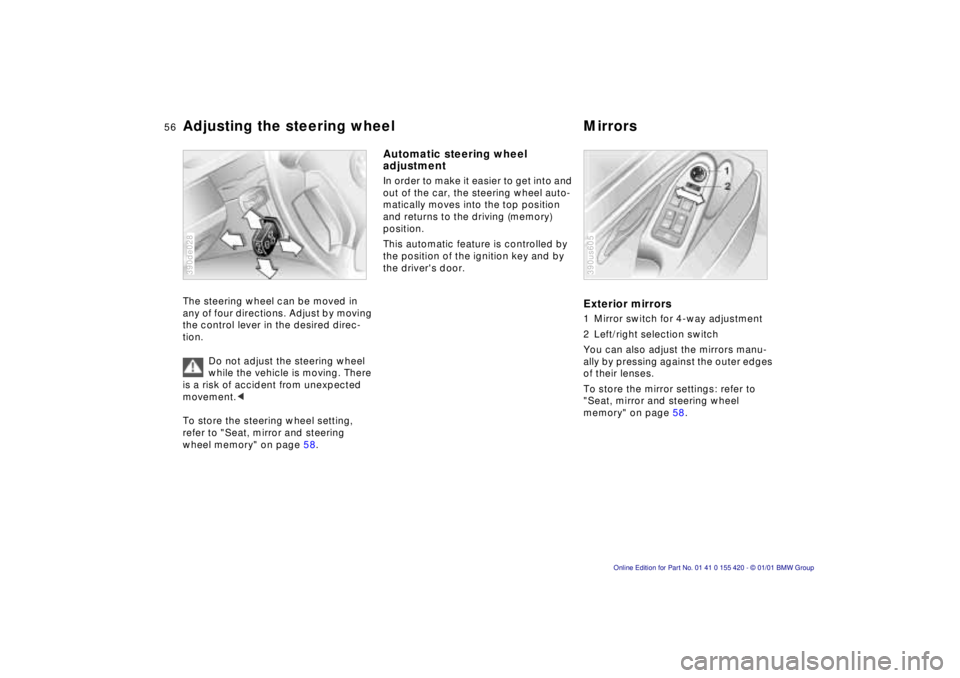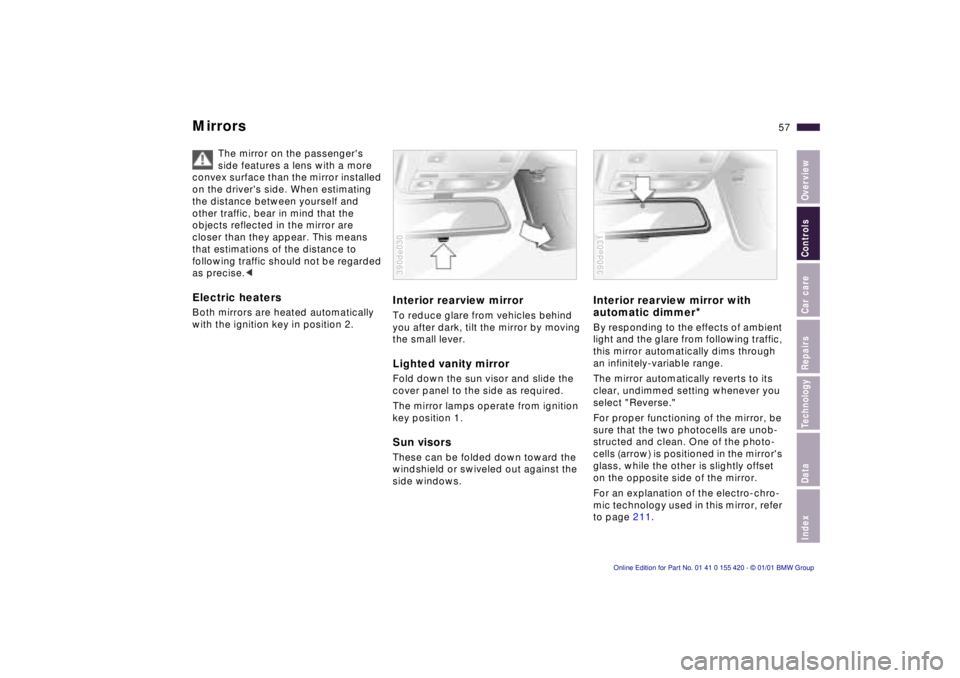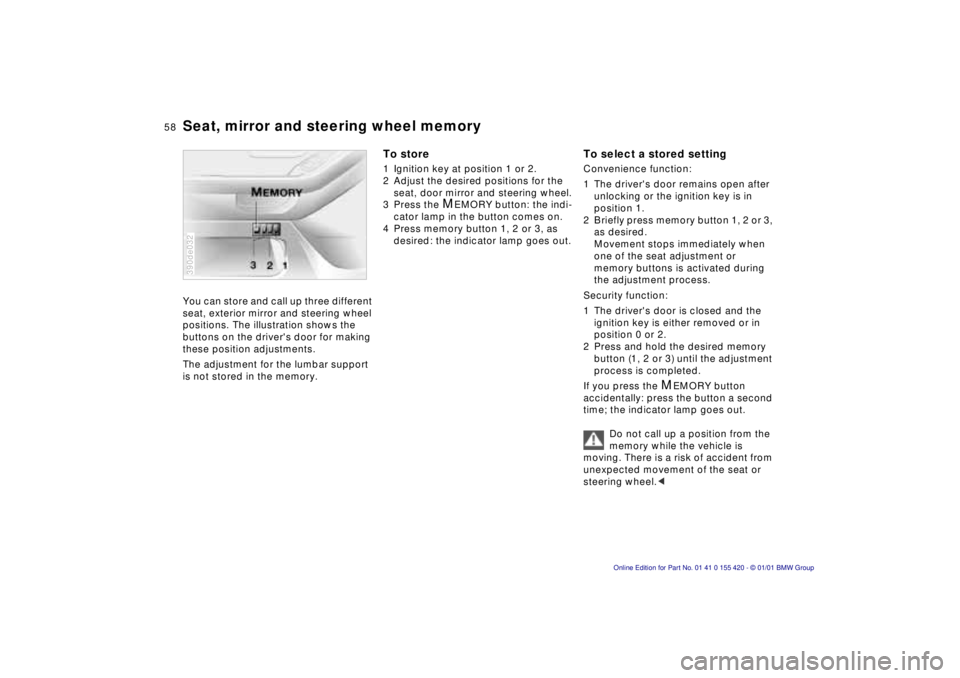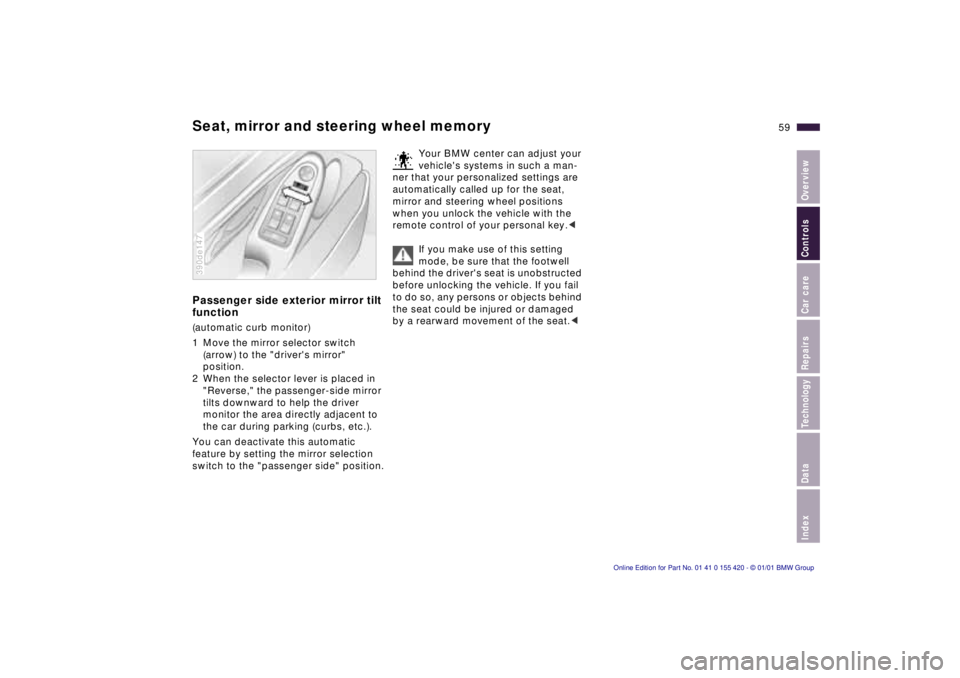2001 BMW 540I SEDAN mirror
[x] Cancel search: mirrorPage 10 of 238

Contents
Overview
Controls and features
Cockpit16
Instrument cluster18
Indicator and warning lamps22
Multifunction steering wheel
(MFL) 25
Sports steering wheel26
Hazard warning flashers27
Warning triangle 27
First-aid kit 27
Refueling28
Fuel specifications29
Tire inflation pressure29
Locks and security systems:
Keys36
Electronic vehicle
immobilizer37
Opening and closing –
from the outside38
With the key38
With the remote control39
Opening and closing –
from the inside42
Luggage compartment lid/
Tailgate43
Rear window43
Luggage compartment46
Alarm system47
Electric power windows49
Sliding/Tilt sunroof50
Adjustments:
Seats52
Steering wheel56
Mirrors56
Seat, mirror and steering wheel
memory58
Car Memory, Key Memory60
Passenger safety systems:
Safety belts61
Airbags62
Transporting children safely66
Driving:
Steering/Ignition lock68
Starting the engine68
Switching off the engine69
Parking brake70
Manual transmission70
Automatic transmission72
Automatic transmission with
Steptronic75
Indicator/Headlamp flasher78
Wiper/Washer system78
Rear window defroster80
Cruise control81
Everything under control:
Odometer, outside temperature
display83
Tachometer84
Energy control84
Fuel gauge84
Coolant temperature gauge85
Service Interval Display85
Check Control86
Computer89
Multi-information display
(MID)91
Digital clock in the MID92
Computer in the MID95
Page 12 of 238

Contents
Operation, care and maintenance
Owner service procedures
Advanced technology
Under the hood:
Hood159
Engine compartment160
Washer fluids164
Washer nozzles164
Engine oil165
Coolant167
Brake fluid168
Vehicle Identification
Number169
Care and maintenance:
The BMW Maintenance
System170
Caring for your car171
Airbags176
Vehicle storage176
Laws and regulations:
Technical modifications177
California Proposition
65 Warning177
OBD interface socket178
Replacement procedures:
Onboard tool kit182
Wiper blades182
Lamps and bulbs183
Changing a wheel190
Battery193
Fuses196
In case of electrical
malfunction:
Fuel filler door198
Sliding/Tilt sunroof198
Tailgate199
Assistance, giving and
receiving:
Jump-starting200
Towing the vehicle201Airbags206
Adaptive Transmission Control
(ATC)207
Automatic Stability Control plus
Traction (ASC+T)/Dynamic
Stability Control (DSC)208
BMW active seat210
Safety belt tensioner210
DSP sound system211
Mirrors with automatic
dimmer211
Rain sensor212
Tire Pressure Control (RDC)213
Integrated rear suspension214
Level control system214
Xenon lamps215
Page 34 of 238

34n
Locks and security systems:
Keys 36
Electronic vehicle immobilizer 37
Central locking system 38
Opening and closing –
from the outside 38
With the key 38
With the remote control 38
Opening and closing – from the inside 42
Luggage compartment lid/ Tailgate 43
Rear window 44
Luggage compartment 46
Alarm system 47
Electric power windows 49
Sliding/Tilt sunroof 50
Adjustments:
Seats 52
Steering wheel 56
Mirrors 56
Seat, mirror and steering wheel memory 58
Car Memory, Key Memory 60
Passenger safety systems:
Safety belts 61
Airbags 62
Transporting children safely 66Driving:
Steering/Ignition lock
68
Starting the engine 68
Switching off the engine 69
Parking brake 70
Manual transmission 70
Automatic transmission 72
Automatic transmission with Steptronic 75
Indicator/Headlamp flasher 78
Wiper/Washer system 78
Rear window defroster 80
Cruise control 81
Everything under control:
Odometer, outside temperature display 83
Tachometer 84
Energy control 84
Fuel gauge 84
Coolant temperature gauge 85
Service Interval Display 85
Check Control 86
Computer 89
Multi-information display (MID) 91
Digital clock in the MID 92
Computer in the MID 95
Page 47 of 238

IndexDataTechnologyRepairsCar careControlsOverview
47n
Alarm systemThe conceptThe vehicle alarm system responds:
>When a door, the hood or the lug-
gage compartment lid/tailgate is
opened.
>To movement inside the vehicle
(interior motion sensor).
>To variations in the vehicle tilt sensor
such as occur during attempts to
steal the wheels or tow the vehicle.
>To interruption of battery voltage.
The system responds to unauthorized
vehicle entry and attempted theft by
simultaneously activating the following:
>Sounding an acoustical alarm for
30 seconds.
>The hazard warning flashers are
activated for approx. five minutes.
>The high beams flash on and off in
the same rhythm.
To arm and disarm the
alarm systemWhen the vehicle is locked or unlocked
with the key or the remote control, the
alarm system is also simultaneously
armed or disarmed.
The interior motion sensor is activated
approx. 30 seconds after you have fin-
ished locking the car.
The system indicates that it has been
correctly armed by switching on the
hazard flashers for a single cycle and by
emitting an acoustical signal.
You can have different acknowl-
edgment signals set to confirm
arming and disarming.<
When the system is armed, you can still
gain access to the luggage compart-
ment lid/tailgate by pressing button 3
on the remote control (refer to page 41).
When you close the luggage compart-
ment lid/tailgate, it locks again.
Indicator lamp displays>The indicator lamp below the interior
rearview mirror flashes continuously:
the system is armed.
>The indicator lamp flashes during
arming: door(s), the hood or luggage
compartment lid/tailgate are not
completely closed. Even if you do not
close the alerted area, the system
begins to monitor the remaining ar-
eas, and the indicator lamp flashes
continuously after 10 seconds. How-
ever, the interior motion sensor is not
activated.
>If the indicator lamp goes out when
the system is disarmed: no manipula-
tion or attempted intrusions have
been detected in the period since
the system was armed.390de020
Page 56 of 238

56n
Adjusting the steering wheel MirrorsThe steering wheel can be moved in
any of four directions. Adjust by moving
the control lever in the desired direc-
tion.
Do not adjust the steering wheel
while the vehicle is moving. There
is a risk of accident from unexpected
movement.<
To store the steering wheel setting,
refer to "Seat, mirror and steering
wheel memory" on page 58.390de028
Automatic steering wheel
adjustment In order to make it easier to get into and
out of the car, the steering wheel auto-
matically moves into the top position
and returns to the driving (memory)
position.
This automatic feature is controlled by
the position of the ignition key and by
the driver's door.
Exterior mirrors1 Mirror switch for 4-way adjustment
2 Left/right selection switch
You can also adjust the mirrors manu-
ally by pressing against the outer edges
of their lenses.
To store the mirror settings: refer to
"Seat, mirror and steering wheel
memory" on page 58.390us605
Page 57 of 238

IndexDataTechnologyRepairsCar careControlsOverview
57n
Mirrors
The mirror on the passenger's
side features a lens with a more
convex surface than the mirror installed
on the driver's side. When estimating
the distance between yourself and
other traffic, bear in mind that the
objects reflected in the mirror are
closer than they appear. This means
that estimations of the distance to
following traffic should not be regarded
as precise.<
Electric heatersBoth mirrors are heated automatically
with the ignition key in position 2.
Interior rearview mirrorTo reduce glare from vehicles behind
you after dark, tilt the mirror by moving
the small lever.Lighted vanity mirrorFold down the sun visor and slide the
cover panel to the side as required.
The mirror lamps operate from ignition
key position 1.Sun visorsThese can be folded down toward the
windshield or swiveled out against the
side windows.390de030
Interior rearview mirror with
automatic dimmer
*
By responding to the effects of ambient
light and the glare from following traffic,
this mirror automatically dims through
an infinitely-variable range.
The mirror automatically reverts to its
clear, undimmed setting whenever you
select "Reverse."
For proper functioning of the mirror, be
sure that the two photocells are unob-
structed and clean. One of the photo-
cells (arrow) is positioned in the mirror's
glass, while the other is slightly offset
on the opposite side of the mirror.
For an explanation of the electro-chro-
mic technology used in this mirror, refer
to page 211.390de031
Page 58 of 238

58n
Seat, mirror and steering wheel memoryYou can store and call up three different
seat, exterior mirror and steering wheel
positions. The illustration shows the
buttons on the driver's door for making
these position adjustments.
The adjustment for the lumbar support
is not stored in the memory.390de032
To store1 Ignition key at position 1 or 2.
2 Adjust the desired positions for the
seat, door mirror and steering wheel.
3 Press the
M
EMORY button: the indi-
cator lamp in the button comes on.
4 Press memory button 1, 2 or 3, as
desired: the indicator lamp goes out.
To select a stored settingConvenience function:
1 The driver's door remains open after
unlocking or the ignition key is in
position 1.
2 Briefly press memory button 1, 2 or 3,
as desired.
Movement stops immediately when
one of the seat adjustment or
memory buttons is activated during
the adjustment process.
Security function:
1 The driver's door is closed and the
ignition key is either removed or in
position 0 or 2.
2 Press and hold the desired memory
button (1, 2 or 3) until the adjustment
process is completed.
If you press the
M
EMORY button
accidentally: press the button a second
time; the indicator lamp goes out.
Do not call up a position from the
memory while the vehicle is
moving. There is a risk of accident from
unexpected movement of the seat or
steering wheel.<
Page 59 of 238

IndexDataTechnologyRepairsCar careControlsOverview
59n
Seat, mirror and steering wheel memoryPassenger side exterior mirror tilt
function(automatic curb monitor)
1 Move the mirror selector switch
(arrow) to the "driver's mirror"
position.
2 When the selector lever is placed in
"Reverse," the passenger-side mirror
tilts downward to help the driver
monitor the area directly adjacent to
the car during parking (curbs, etc.).
You can deactivate this automatic
feature by setting the mirror selection
switch to the "passenger side" position.390de147
Your BMW center can adjust your
vehicle's systems in such a man-
ner that your personalized settings are
automatically called up for the seat,
mirror and steering wheel positions
when you unlock the vehicle with the
remote control of your personal key.<
If you make use of this setting
mode, be sure that the footwell
behind the driver's seat is unobstructed
before unlocking the vehicle. If you fail
to do so, any persons or objects behind
the seat could be injured or damaged
by a rearward movement of the seat.<